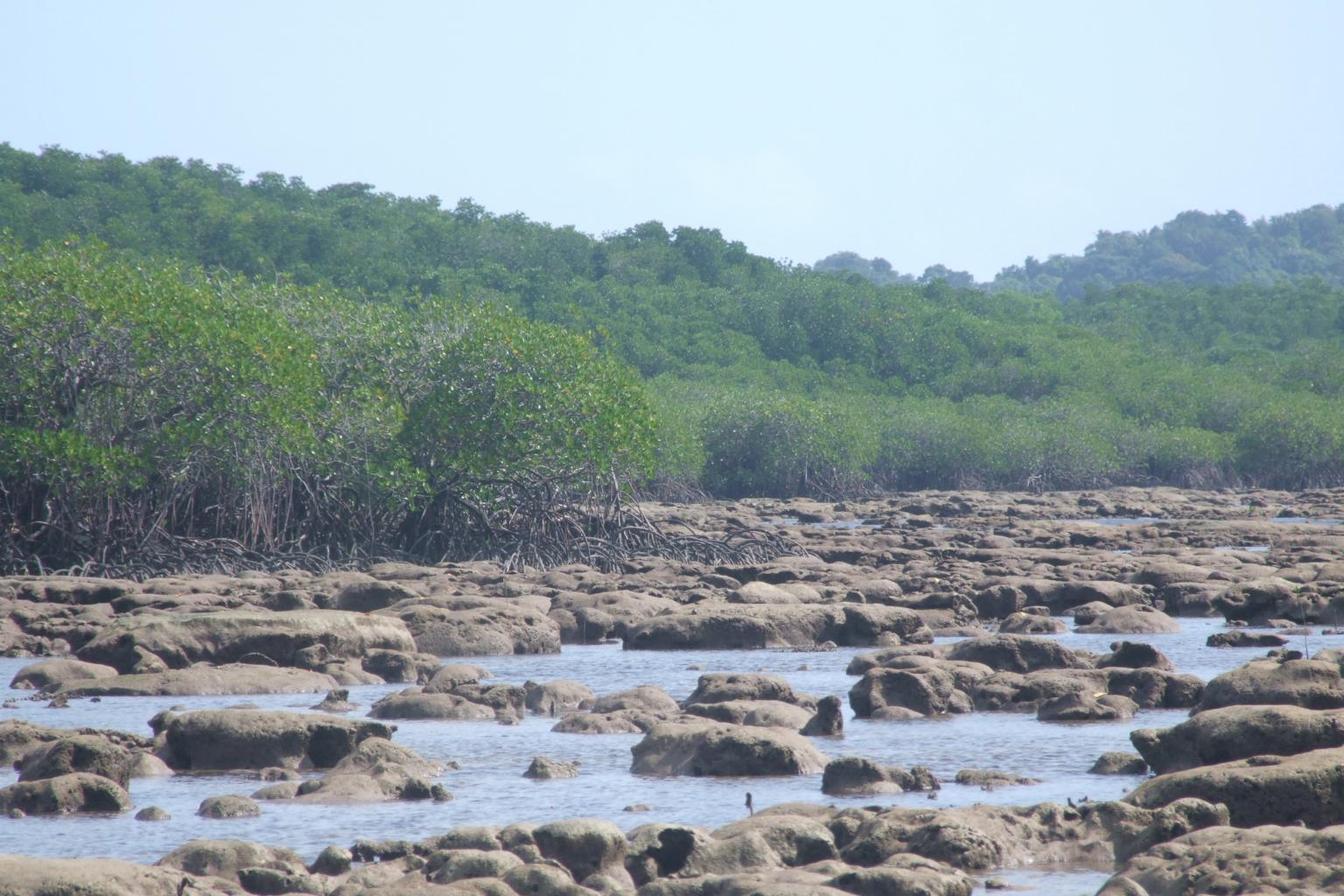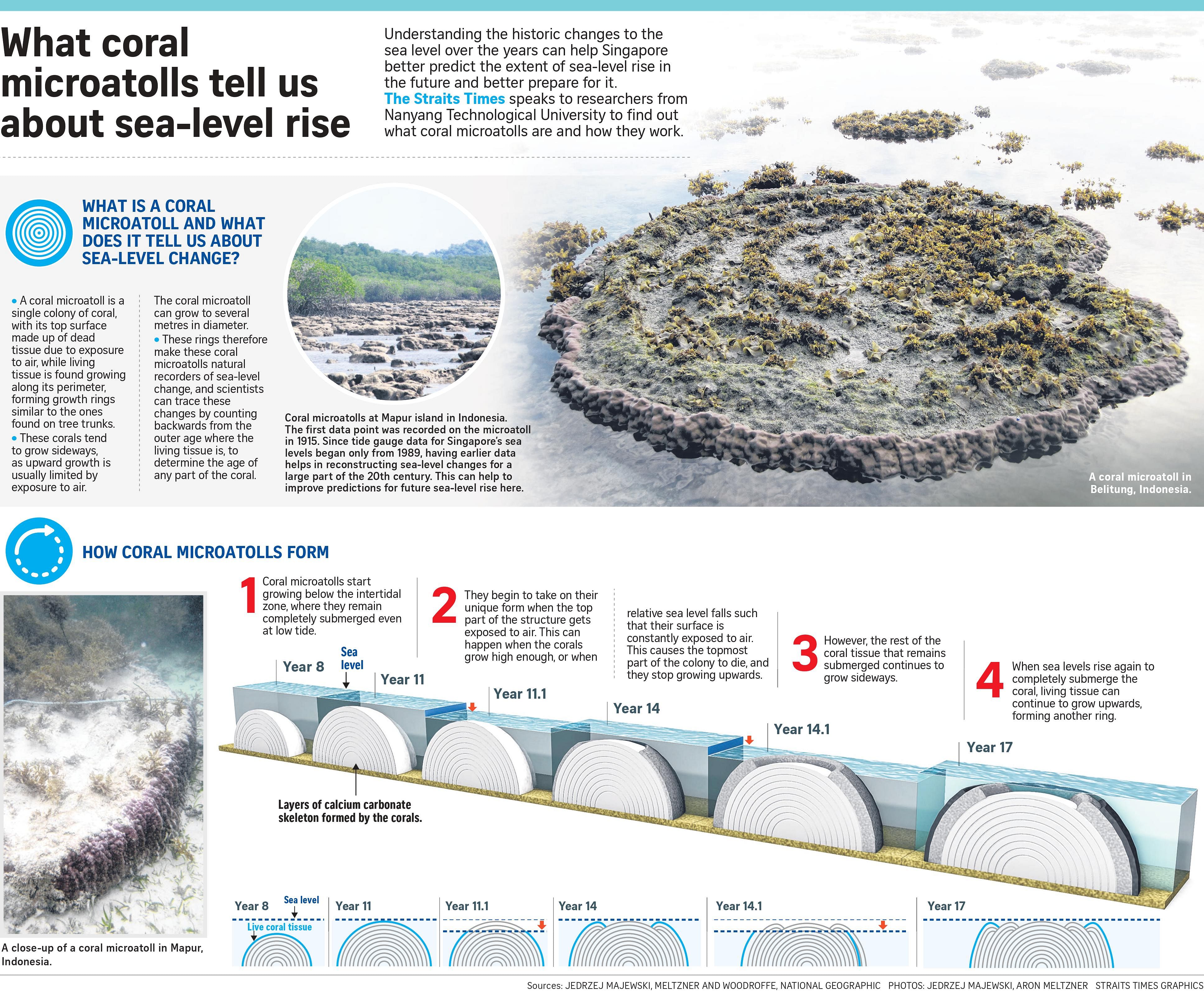Corals show rising sea levels in Singapore 'very likely' due to climate change
Sign up now: Get ST's newsletters delivered to your inbox

The coral microatolls at Mapur island in Indonesia can provide a good gauge of Singapore's sea-level history over the past century.
PHOTO: JEDRZEJ MAJEWSKI
Follow topic:
SINGAPORE - Corals can provide a good gauge of Singapore's sea-level history over the past century, with the rising levels recorded over the 20th and 21st century very likely a result of climate change.
While this can be attributed to multiple factors such as sinking land, findings from a Nanyang Technological University (NTU) study show that climate change contributed to rising sea levels in the country. Data from the Meteorological Service Singapore in 2020 had shown that sea levels in Singapore had gone up by 14cm since pre-1970 levels.
Dr Jedrzej Majewski from the Earth Observatory of Singapore (EOS) at NTU, who is the lead author of the study, said that as the rate of sea-level rise over the last 100 years was lower compared with the global average, taking away anthropogenic factors would mean that sea level in the country could have been stable, or even "slightly falling", likely due to Singapore's geological history.
Anthropogenic factors refer to human activity, such as the burning of fossil fuels and cutting down of forests.
In addition, taking into account the recent report by the United Nations' Intergovernmental Panel for Climate Change (IPCC), some 70 per cent of the combined change in glaciers, ice sheet surface mass balance and thermal expansion since 1970 can be attributed to human activity - with this percentage increasing over the course of the 20th and 21st century, he noted.
The latest report from IPCC has found that Singapore will face a sea-level rise of about 0.2m by 2050, and 1m by 2100, relative to a baseline from the period of 1995 to 2014.
This discovery was made possible only through the use of coral microatolls - circular colonies of coral which usually grow sideways - from Mapur, an Indonesian island about 100km south-east of Singapore.
Dr Majewski added that the corals there can provide a good gauge of Singapore's sea level history over the past century.
The top surface of the coral microatoll is usually made of dead tissue due to exposure to air, while living tissue is found growing along its perimeter, forming growth rings similar to the ones found on tree trunks.
These rings, therefore, make these coral microatolls natural recorders of sea-level change, and scientists can trace these changes by counting backwards from the outer age where the living tissue is, to determine the age of any part of the coral.
Assistant Professor Aron Meltzner from EOS, who co-led the study, noted that tide gauge records from Tanjong Pagar on Singapore's sea levels went back only to 1989, whereas the first data point recorded on the coral microatoll dated back to 1915.
"Between 1915 and 1990, sea-level rise in Singapore was slower than the global average, and sea level was essentially stable.
"However, before this study, we could only extrapolate the probable sea level in Singapore from a global average and the more recent tide gauge records. This left quite a bit of uncertainty about how high sea level was and how it changed over the period," said Prof Meltzner.
Dr Majewski said the microatolls allowed researchers to narrow down the uncertainty of probable sea levels in Singapore by over 40 per cent for earlier periods, and about 30 per cent for the more recent period of time.
Likening sea-level data to investing in the stock market, if one looks only at the past two weeks of historical data and notes that a share had fallen by 10 per cent or 15 per cent, one might think that investment would be a "terrible idea", he added.
"However, if you extend the data to maybe a month, perhaps you would then see that the stock price had risen, and then fallen down. And if you extend the time period to 50 years, you'll see that the recent period is a tiny, tiny little blip in over 30 years of growth," said Dr Majewski.
The same can be extrapolated to sea levels. With current data that stretches only to the 1990s, the team is able to see only a small part of the big picture, while longer-term data provides a fuller picture, he added.
"This background will be incorporated into future models, allowing experts to be more precise with their predictions of future sea levels, and for those in Singapore to have a better understanding of how the regional sea-level change may differ from the global average," he said.
Dr Majewski pointed out that the youngest coral microatoll records were cross-referenced with tide gauges in Tanjong Pagar from 1989, thereby validating their potential use in reconstructing sea-level change in South-east Asia, as he noted the lack of data for the region as a whole in the latest IPCC report.
"There are a lot of places which didn't have any tide gauges installed until maybe the 1980s or the 1990s, or still don't have any tide gauges presently. So if they had any corals growing, and if we found the right ones, we can actually reconstruct the sea-level change over the past 100 or 200 years," said Dr Majewski.
Prof Meltzner said the team is currently studying the microatolls in the Southern Islands, with plans to conduct similar studies in other sites in Indonesia and Malaysia.
These can give more robust data on how sea-level rise may have a varied impact on different parts of Singapore, given how different areas may have had varying sea-level histories.


